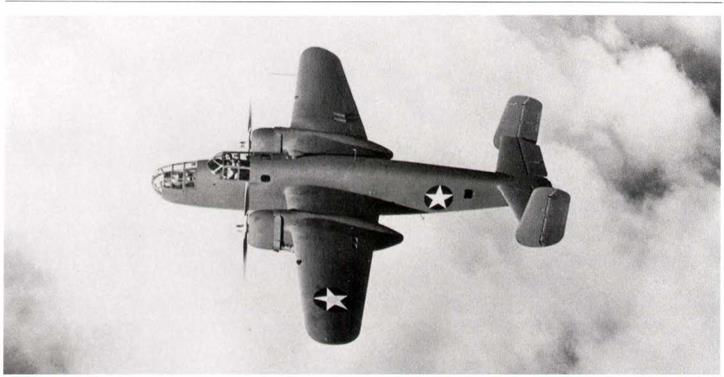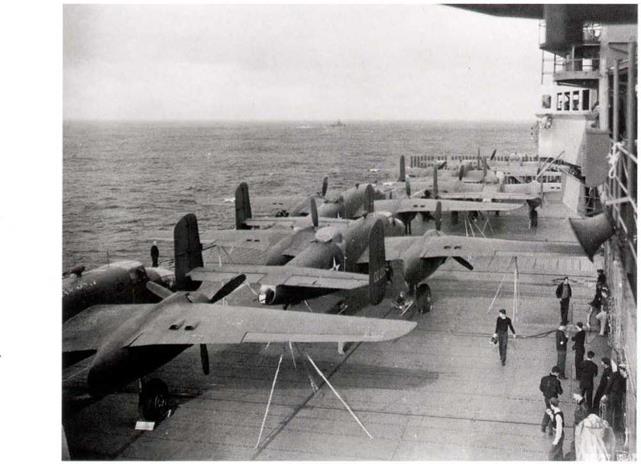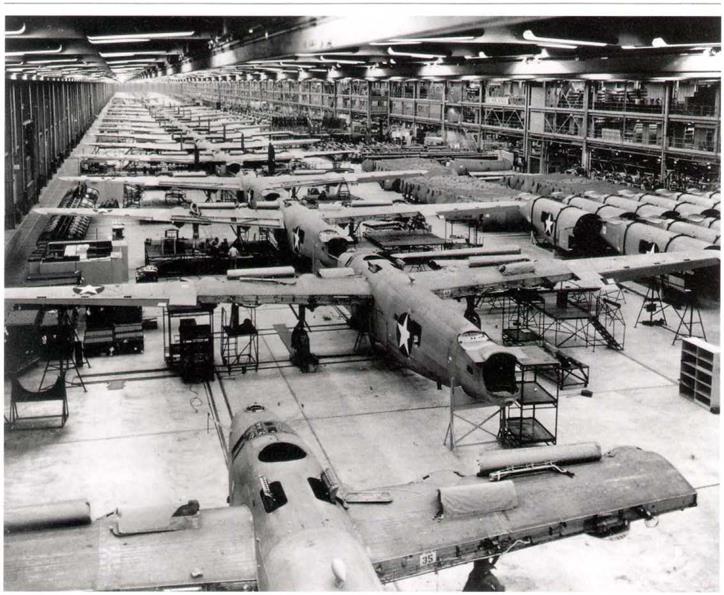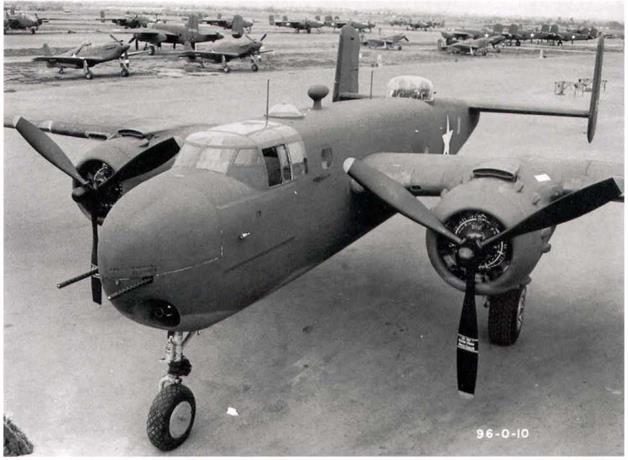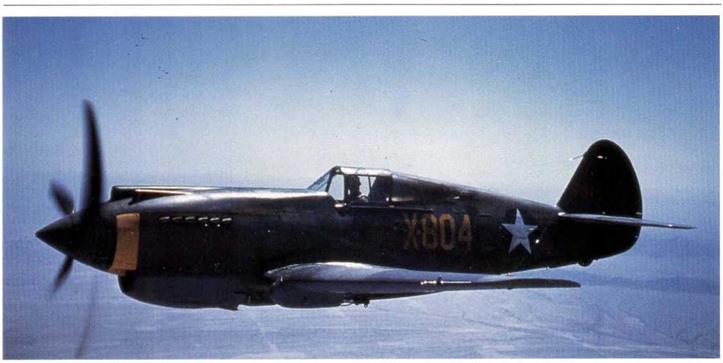White and Haze Paints tested on Pursuit Aircraft, January 1942
Exp. Eng. Sect. (WF), investigated the method for camouflaging pursuit aircraft which were being used in studies of photographic installations. Two kinds of paint were used for the tests, namely:
(1) Cabot Haze Paint, which was a colloidal dispersion of zinc oxide in oil. The plane had a bluish appearance (sky) when the paint was applied in a thin coating over a black background.
(2) A pinkish white and a micaceous paint procured from the Lowe Bros. Paint Co, Dayton, Ohio (hereafter Lowe Bros.) The tentative conclusions were that a flat white camouflage paint was most suitable for camouflage against clouds and the haze paint was preferable for blue-sky conditions. Exp. Eng. Sect, stated that further tests would be conducted to ascertain satisfactory results.
|
North American B-2SA-NA, one of forty buiit before production shifted to the improved B-25B-NA version. The beam and ventral gun positions of the B-25A were replaced on the B-25B by dorsal and ventral gun turrets with two 0.5 inch guns each. (March AFB Museum) |
Permanent Camouflage Paints tested in Florida, January 1942.
Suitable finishes for permanent camouflage of aircraft were discussed in a report prepared by WF. Laboratory tests of applications and removal, adhesion, durability and optical reflection characteristics were included in the investigation. WF concluded that, after five months of Florida exposure, permanent materials, of low gloss, color retention and satisfactory adhesion, had been developed, A method of measuring the specular gloss of camouflage finishes had also been developed.
|
Six of the sixteen B-25B-NAs on (he deck of the USS Hornet, Only visible radio call number is 40-2283. (USAF) |
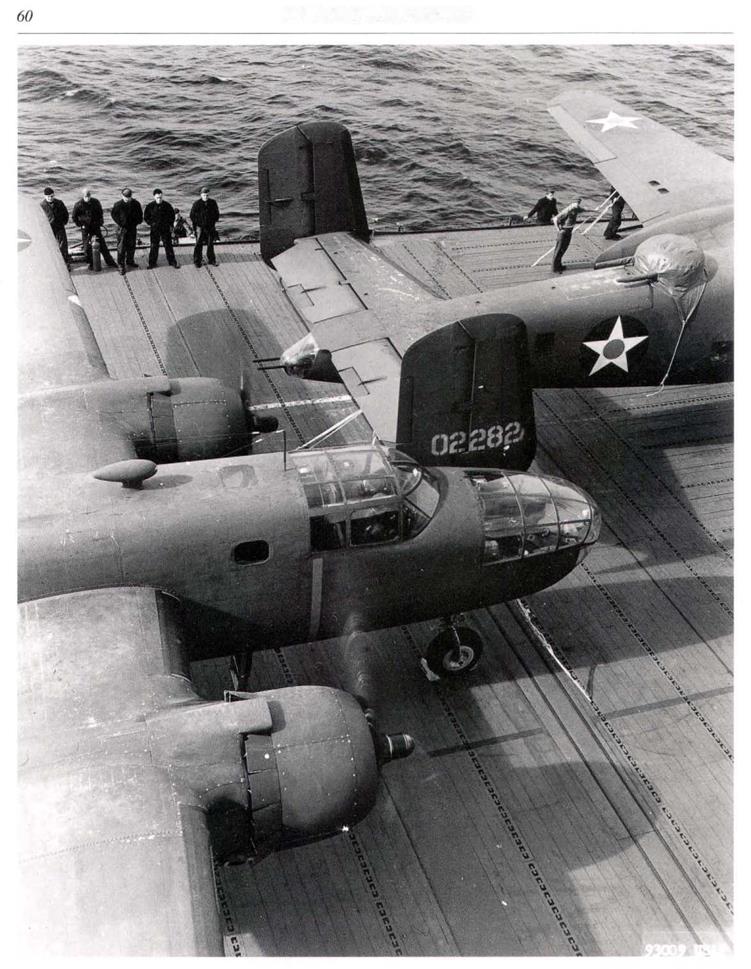 Two of the B-25B-NA* of Col. Jimmy Doolittle’s Tokyo strike force on the deck of the carrier CSS Hornet, on April 18,1942. The right aircraft is 40-2282. Note how crammed the aircraft were on the deck. (USAF)
Two of the B-25B-NA* of Col. Jimmy Doolittle’s Tokyo strike force on the deck of the carrier CSS Hornet, on April 18,1942. The right aircraft is 40-2282. Note how crammed the aircraft were on the deck. (USAF)
|
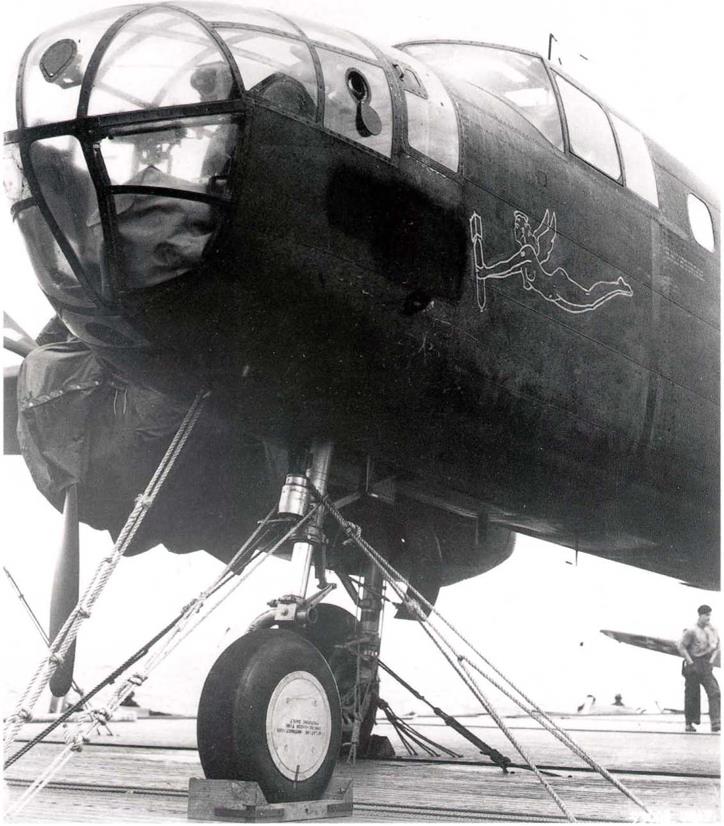
|
Douglas B-18B-DO, 37-530, in Theater 5, the Caribbean and British West Indies area. It is fitted with a very early MAD {Magnetic Anomaly Detection) boom, which appears to have its cover installed upside down. Although it has the post May 1942 cocarde without the red center circle, it is still in dark olive drab and neutral gray finish, despite the drive for a white anti-submarine aircraft finish. (USAF) |
Request by the RAF for standardization of B-I7E camouflage, January 28,1942.
The RAF requested that the JAC make another effort to standardize the camouflage being applied to B-17Es at the modification centers, commenting that the previous differences of location of operational units of the two countries did not now apply, so it should be possible to find a common camouflage scheme for each class of aircraft. Under the aircraft allocation pooling then in force, it was difficult to paint different patterns at the manufacturing plants.
Technical Sub-Committee On Camouflage decides that the AAF basic camouflage scheme and the U. S. Navy basic camouflage scheme be accepted as the production standard for all aircraft produced in the U. S. March 5, 1942.
The Technical Sub-Committee on Camouflage met on March 5, 1942, to discuss the problems raised by the British Air Committee requiring that British camouflage schemes be painted at the factory on all aircraft destined for the RAF and FAA. This was to be applied
|
A Curtiss P-40E, ‘585’, being towed in Alaska. It has the famous Aleutian Tiger markings, plus white stripes on the fuselage and rudder. Note the blue and gray PBY in the background. (USAF) |
|
Convair B-24E-DTs on the new production line at the Douglas Tulsa plant in 1942. Ten B-24Ds and 167 B-24Es were built on this line before shifting to the later B-24H version. This photo is a graphic reminder of the enormous production capacity of the US aircraft industry, built up by joint planning between the ЛАТ and civilian industry. More B-24s were built than any other US aircraft in World War 11, but it was taken out of service almost overnight at the end of the war. (Harry Gann) |
either before the aircraft left the U. S. or after it reached the British theater of war. The British also stated that it was impossible for them to accept the U. S. camouflage schemes operationally.
The Sub-Committee decided that it was impracticable to adopt the British schemes as standard, because that system was based on the Service being able to anticipate the aircraft’s operational theater or role while it was being completed at the manufacturer.
They then considered camouflage schemes which could be used as a basis for all aircraft and could be converted to other services requirements with the least difficulty. It was agreed that this consideration could be converted into two standard basic schemes, (1) camouflage for land based aircraft, (2) camouflage for ship based aircraft, this to also include flying boats.
The British representative stated that 70% of the British camouflage schemes used a “Dark Green,” which was very similar to the Army dark olive drab, thus they could accept this in lieu of the Dark Green throughout the camouflage programs. For ship based aircraft, the British stated that the U. S, Navy colors would be acceptable.
The current policy of pooling all aircraft production was given as a very strong reason to accept the two basic camouflage schemes, and this was accepted by all present. It was also recommended that the requirements for insignia and markings of a particular Service be accomplished as follows:
a. When the allocation of aircraft was determined before production was complete, the insignia and markings of a particular Service would be applied at the factory.
b. When an aircraft was diverted from one service to another, the change of insignia and markings would be made at the modification centers.
In conclusion, the British representatives at the meeting agreed to submit the U. S. Navy camouflage system to the authorities in Great Britain for a decision as to whether or not it was acceptable. It was also agreed that the British would submit to the U. S. Army their specific requirements for camouflage on all types of Army aircraft in production in the US.
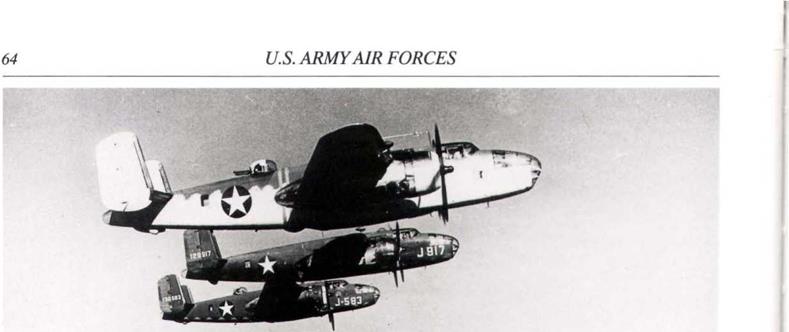 |
One North American B-25C-NA, 41-12848, with two B-25Ds, operating in the anti-submarine role. B-2SD-1-NC, 41-29917, has no ventral turret, while B-25D-20-NC, 41-30583 has both ventral and dorsal turrets. The latter aircraft were the Kansas city built version of the B-25C. Note the white anti-submarine finish on the B-25C. (Harry Gann)
Responsibility for Aircraft Camouflage development defined, April 1942,
At this time, the Chief of Engineers was the War Dept. Agency responsible for the development of protective coloration and camouflage of all items of equipment, supplies and materials except aircraft. The Air Corps Board had held that responsibility for aircraft since 1940, while the Exp. Eng. Sect. (WF) was responsible for the material necessary for the camouflage.
The Director of Base Services (Washington) on April 2,1942, recommended that;
The Air Corps Board continue their responsibility for the development of means and methods for the camouflage of aircraft in flight and on the ground.
|
![]()
|
A training unit Curtiss P-40A, 39-1804, from Luke Field, Arizona, as designated by the X-804 on fuselage side. The band under the nose and the aircraft field number are yellow, (USAF) |
Chief of Engineers continue development of all materials for camouflage of aircraft on the ground.
The Dir. of Mil. Req. (Wash.) be responsible for the approval and execution of camouflage schemes.
The Dir. of Mil. Req. pointed out on April 8, 1942, that the Air Corps Board had been inactivated as such, and functions were being handled by the AAF Proving Ground Command, Eglin Field, Florida, operating under Dir. of Mil. Req. That Directorate would now be accountable for the approval of camouflage schemes for aircraft developed by Material Command or Air Service Command. (Note: this points out how difficult it had been for Gen. Arnold to get a complete grip on the responsibilities and authority of the recently formed USAAF).
Gen. Arnold directs that “summer” camouflage be put immediately on all aircraft leaving U. S., March 14,1942.
Gen. Arnold caused some confusion by directing that “summer” camouflage be painted immediately on all aircraft leaving the U. S. He ordered that machinery was to be established so that camouflaging would be automatic as soon as it was determined for which theater the plane was destined. Brig. Gen. Fairchild, Dir. of Mil. Req. (Wash.), on April 7,1942, pointed out that there was no summer camouflage, but that the Joint Aircraft Committee (JAC) had approved the following camouflage for all land-based aircraft produced in the U. S.:
a. Surfaces seen from above to be painted the Army olive drab; surfaces seen from below to be painted a neutral gray. For night operations, a flat black color was to be used.
Prior to this, on March 19,1942, the Eng. Sec.(WF) had been told of Arnold’s order by the Prod. Eng. Sec., Washington. They replied on March 25, 1942, that after Study 42 had been conducted, it had been decided that all tactical aircraft should be camouflaged with a uniform design and color. They therefore recommended that all aircraft leave the country with the standard camouflage finish and that the special colors be applied in the combat zone to suit the particular terrain. This recommendation was based on the difficulty presented by the ever changing military situation.











